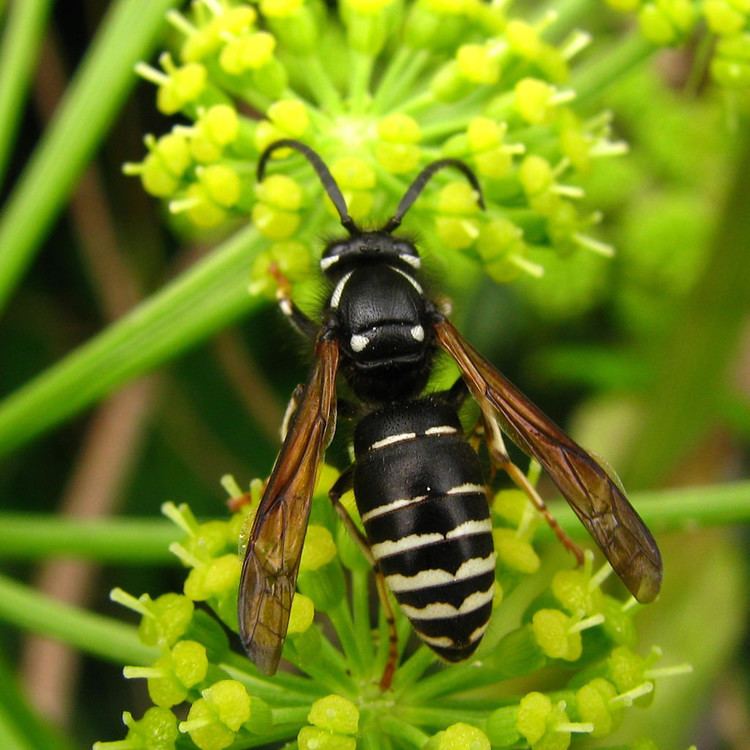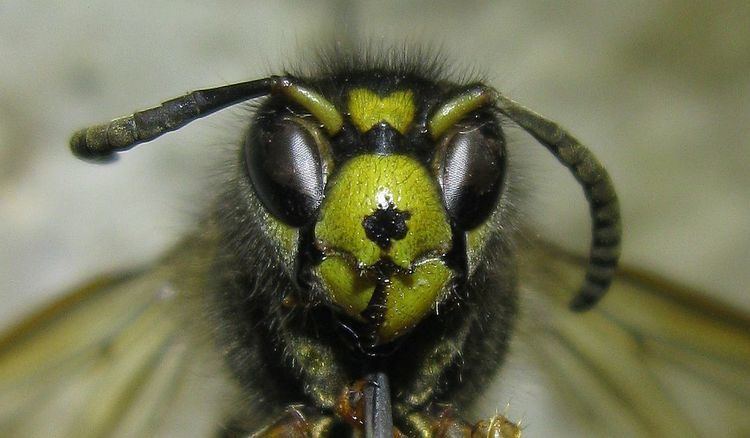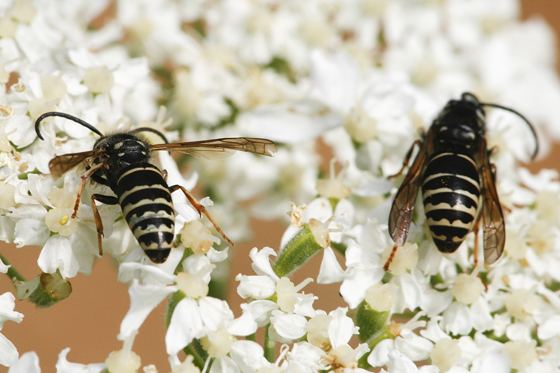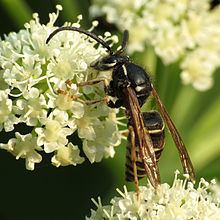Suborder Apocrita Rank Species | ||
 | ||
Similar Vespula austriaca, Dolichovespula norwegica, Dolichovespula saxonica, Dolichovespula, Dolichovespula sylvestris | ||
Dolichovespula adulterina is a species of parasitic social wasp. D. adulterina lives in the Palearctic and Nearctic regions but parasitize different host species depending on which region it inhabits. D. adulterina feeds on a variety of foods including insects, spiders, arthropods, meat, mollusks, fruit, nectar and larval secretions. D. adulterina is synonymous with D. arctica from the Palearctic region.
Contents
- Taxonomy and phylogeny
- Identification
- Distribution and habitat
- Nearctic habitat
- Palearctic habitat
- Colony cycle
- D arenaria
- D saxonica
- Parasitic behavior
- Diet
- Foraging
- Mauling
- Larval communication
- Sting
- Emerys rule
- Worker queen relationship
- Biology
- References

Taxonomy and phylogeny
Dolichovespula adulterina is a parasitic wasp that falls under the order Hymenoptera. It is a member of the subfamily Vespinae and was labeled a subgenus of the genus Vespula at one point. Dolichovespula are identified by gently notched labrum on the ventral border. This is the location of sensory bristles. Dolichovespula exhibit microscopic spinous growths all over the palate region, whereas other species have localized growths. Another distinctive feature is the monodentate mandible, where the primary incisor is always linear. Dolichovespula construct their nest out of pliable carton. Vespula will also construct their nests out of a pliable carton, suggesting they may be related. Other relations to Vespa include the similar long-collar outgrowth on the spiracle, an opening that leads to the respiratory system. Its body size is nearly identical in size to species of Vespula.

D. adulterina is a member of a monophyly with D. omissa. This monophyly is characterized by the absence of a worker caste, apical angle of the clypeus, dorsally effaced occipital carina, and a stinger that is bent backwards. D. adulterina is classified within its genus by the divergence of the Cu1 vein at the insertion of the cu-a cross-vein.

Dolichovespula adulterina has different host species in North America and in Eurasia and this strongly suggests that the two populations of their parasites are different species. A review of the North American wasps in 2012 suggested the name Dolichovespula arctica for the North American species.
Identification

The length of the forewing is 13.0–14.0 mm in females and 10.0–12.0 mm in males. Commonly, their body is an ivory color but it can be pale yellow on occasion; the pale yellow subspecies are found in the western Nearctic and Palearctic regions. Usually, the clypeus is elongated but sometimes it will be small and round. In females there is almost always a black disc-like spot whereas males will have a black mark that extends to the ventral margin of the clypeus. Melanic individuals will have a black spot extending to the dorsal margin. The post-ocular band in females is narrower relative to the lateral post-ocular stripes whereas in males it is rarely narrowed. Occasionally, small ivory sports will be located on the pronotum behind the pronotal fovea. Females present with pairs of black discal spots on tergum 5, and occasionally on terga 3 and 4 as well. In males, tergum 6 will usually be black and less developed fascia than previous terga. Furthermore, in males tergum 7 is usually black and rarely contains two ivory spots.
A black and white, sometimes pale yellow, wasp with brown-tinted wings. Normally, abdominal segments 1-5 are bordered, towards their rears, with a thin white band. The large dark malar space between the eye and the yellow jaw puts this species in the genus Dolichovespula rather than the wasps of the related genus Vespula.
Distribution and habitat
D. adulterina has a Holarctic distribution, meaning that it is found in the vast majority of habitats in northern continents. Subdivisions of the Holarctic include the Palearctic, which consists of North Africa and Eurasia excluding southeast Asia and India, and the Nearctic, which consists regions of North America north of southern Mexico.
Nearctic habitat
In the Nearctic, D. adulterina parasitizes D. arenaria and D. alpicola.
D. arenaria resides in various climates. It lives in altitudes anywhere from sea level to 3350 meters above sea level. Nests can be found in trees, shrubs, bird boxes, underneath rock overhangs, and decayed logs. Some nests are built in piles of leaves and at a shallow depth in soil.
D. alpicola is found in mountainous regions and lower altitude regions of Alaska in coniferous forests. It is predominantly found in altitudes between 1700 and 3300 meters above sea level.
Palearctic habitat
In the Palearctic region, D. adulterina parasitizes D. saxonica and D. norvegica.
D. saxonica construct nests in trees and shrubs no more than 2 meters above the ground. Sometimes, D. saxonica will nest in beehives, underneath overhanging edge of roofs (sometimes up to 7 meters above ground) and porches, in cavities of walls. On occasion, they may also nest in tree holes or holes in the ground.
Colony cycle
Due to D. adulterina’s parasitic nature, its life cycle is consistent with the host it parasitizes. Furthermore, D. adulterina will invade the nest of host species before the first set of workers appears and will live alongside the queen for a period of time before usurping her.
In the Nearctic region, D. adulterina parasitizes D. arenaria and D. alpicola and thus follows suit with their colony cycle.
D. arenaria
D. arenaria located in the northwestern United States will initiate their colony around late May. The first workers will show in mid-June. The construction of large cells takes place starting in early June. After the emergence of the first queens in late July, the colony will end in early September. In the southern regions of central California, it was documented that colonies will start earlier in late March and terminate at the end of July. This gives the colony a cycle of approximately 4.3 months.
For D. alpicola, colonies won’t initiate until late June or early July. The workers emerge and begin their roles in October. Activity of males will continue to October.
D. saxonica
In Palearctic regions, D. adulterina parasitizes D. saxonica. In mid-May or just beforehand, colonies initiate. The first set of workers emerge in early June and begin working on large-cells mid-June. Queens will emerge in early July and the colony continues until just after mid-August.
Regardless of the host species, the queen D. adulterina invades the host colony around the same time that the first workers start to emerge. The invasive queen waits approximately 10 days before killing the host queen and laying her eggs. Males emerge in late July and new queens emerge in early August. After a few days, the males and females will leave for their mating flights. The colony then terminates in mid-August. The inquiline queen dies by mid-July, if not earlier from fights with host workers. After the colony ceases, the queen will enter hibernation in a sheltered area. She will then emerge and feed on nectar and malaxate arthropods until she attempts to usurp a host colony. On average, the colony cycle for a successful parasitic queen is about 2.8 months.
Parasitic behavior
Social insects are labeled parasites when the parasitic female will enter the host nest and assume the reproductive responsibility of queen while simultaneously leading the pre-existing workers. Dolichovespula adulterina is an inquiline species, meaning that workers are not produced. One of its hosts species is the Dolichovespula norwegica wasp, although this was not accepted by some authorities for some time, indirect evidence was the presence of D.adulterina in regions where D saxonica was absent but the related D. norvegica was present and this was confirmed by direct observation which had been published in regional journals. Furthermore, they do not have a worker class and they do not construct nests. Instead, they will use the host nest and workers to raise their offspring.
Different inquilines utilize different tactics to invade and control nests. D. adulterina assumes a more passive behavior while invading the nests of D. arenaria. This is done through their use of a submissive stance while the hive is under attack. Furthermore, D. adulterina will live alongside the host queen for a while before attempting to kill her. This is different from other inquiline species such as V. austriaca who will attack the nest’s queen immediately. During its time in the nest, D. adulterina is an active member of the colony, feeding larvae and constructing portions of the nest. Workers of the host species were observed interacting with the D. adulterina, suggesting that the parasite may emit a chemical that pacifies the host. This is also supported by the presence of an enlarged Dufour’s gland relative to other vespine species. Time of invasion will also differ between species. D. adulterina will invade the nest of the host species before the first set of workers appear whereas Vespula austriaca invades after the emergence of the first set of workers.
Diet
Due to their inability to store honey, wasps are primarily carnivorous. They will feed on a multitude of insects, spiders and arthropods. To do this, adults will malaxate prey and feed on the juices. Other times they have been observed eating meat, mollusks, fruit and nectar. Larvae produce a secretion that adults feed on as well. Wasps will limit themselves to attacking live prey but other species have been observed to feed on carcasses. Trophallaxis is a common process among wasps, where one member will transfer food to another member by feeding it mouth-to-mouth. Members of the host nest are mainly responsible for feeding the parasitic D. adulterina larvae.
Foraging
Foraging behaviors among Dolichovespula is largely visual but odors also trigger workers to attack. When hunting, workers hunt independent of each other. Their inability to communicate food sources to other workers proves a challenge for the colony. Workers will begin to forage 1 hour before sunrise and end 1 hour after sunset. Foraging peaks during the early morning, falls slightly and then slightly escalates in the evening. Foraging behavior relies on light intensity. Workers forage anywhere from 180 to 275 meters away from their nest.
Mauling
Mauling is a behavior observed in Dolichovespula where one member will chew another individual that remains motionless throughout the act. Increased mauling behavior was thought to be associated with a dominance hierarchy, where the more dominant individuals would maul the relatively inferior individuals and demand food. This theory was contested later and requires additional research in order to validate the initial claim. Workers marked by an unusual scent that returned to the colony were mauled as well. The exact reason as to why this occurs is unknown.
Larval communication
In order to indicate hunger, larvae produce a sound by scraping the sides of their cell. Dolichovespula queens and workers communicate with the larvae, as well. While stationed on top of the comb, queens and workers produce a dorso-ventral gastral vibration. Once a larvae is fed, the vibrations always end, indicating that the vibrations inform the larvae that there is food available.
Sting
Due to their parasitic nature, D. adulterina possesses a modified stinger that contributes to its needs. Specifically upon examination of female specimens, it was noted that their capacity for combat was higher than the average host species. The cuticle of the stinger is thicker than average and is curved. These modifications allow for D. adulterina to effectively penetrate the intersegmental membranes of the host. D. adulterina are better equipped defensively as well. The abdominal sclerites are closer together, providing a smaller gap for incoming stingers to penetrate, thereby decreasing chances of injury.
Emery's rule
Vespula austriaca, D. arctica, D. adulterina, and D. omissa are the only four wasp species that display inquilinism. Furthermore, all of these species abide by Emery’s Rule which states that a parasite will be more closely related to its host than to any other species. It has been shown that in host colonies, D. adulterina queens have allomonal control over worker wasps. While D. adulterina is able to comfortably coexist with its host, it does not integrate nearly as well into host colonies as inquiline ant species. Due to its mediocre proficiency, inquiline wasps are only able to parasitize other species that exist in small colonies and have short cycles.
Worker-queen relationship
There is a particularly weak social hierarchy displayed in Dolichovespula between the queens and workers. Queens will often participate in activities that normally only workers engage in. This includes malaxating prey, trimming the caps of cells, and being mauled by workers. Relative to Vespula, this is indicative of a more primitive behavior.
Biology
The main host of this species in Europe is D. saxonica but it will also parasitise D. norwegica. This species produces no workers, the eggs laid in the host's nest produce queens and males which are nurtured by the worker's of the host species.
